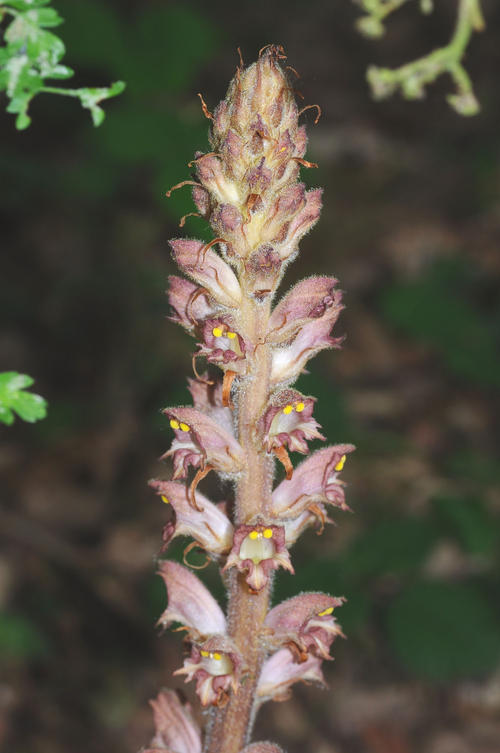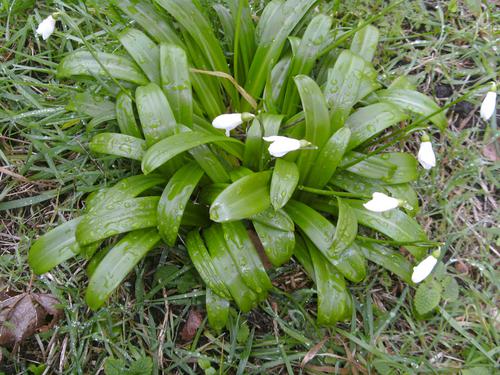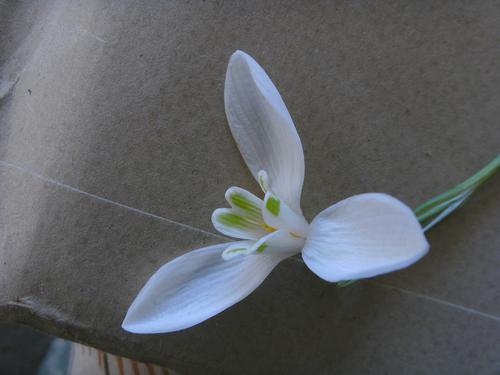Vascular Plant Records – Update February 2012
Bert Reid
In the last Worcestershire Record my article on vascular plant records included a record for Greater Broomrape Orobanche rapum-genistae at Birchfield, Upper Rochford (Fig. 1.). John Day, Bert Reid and Brett Westwood were shown as the recorders but unfortunately I omitted to mention that the plants were initially spotted by John Bingham, who drew them to the attention of at least seven recorders including the three listed. I apologise for my careless error. John Bingham’s sharp eyes gave all who attended the field meeting the opportunity to enjoy the sight of this rare plant.
In the same article, I also floated the idea of setting up an e-mail group to co-ordinate botanical recording in Worcestershire. I asked anyone who wanted to join in and help to e-mail me at bert_reid@talk21.com. Only two people replied to the invitation, so I repeat it here. You don’t have to be an expert to join in. If you can recognise a few easy plants and make occasional lists for your local area you will create useful data that I can use within both national and local projects. But I need more people if we are to set up specific botany field meetings, training days and other activities. If you are unsure what we might do, or whether your contribution would be of any use, please contact me. I will be attending all the general field meetings this year, and will be pleased to see any of you there.
Recording in winter is often ignored by botanists, with most people content to wait for the full flush of spring flowers before venturing out in the field. This is unfortunate because some plant recording is often rewarding in the winter months. Some plants, like Mistletoe Viscum album, Winter Heliotrope Petasites fragrans and Winter Aconite Eranthis hyemalis can be easier to spot before other vegetation comes into leaf. Another advantage is that the restricted range of vegetation enables the recorder to look more closely at the vegetative characteristics of what is around and to practice their skills of identifying plants when they are not in flower. Two examples, both from February 2012, show what can be seen in the ‘dead’ months.
The first example comes from Wyre Forest where John Bingham found about a dozen small clumps of Floating Club-rush Eleogiton fluitans in a small pool backwater in Hitterhill Coppice. This native plant is scarce in Worcestershire, only known six tetrads since 1987 and only three believed to be still extant. This is only the second in the Wyre Forest area (John was also responsible the other Wyre record in 2008, about 0.5km from the new record). Many aquatic plants are available in the vegetative state throughout the year, and although some are very difficult to identify, others are much more straightforward, so they should not be ignored.
The second example is very different, being a non-native plant in full flower in February. The author was seeing what he could find in the early months of the year when he saw abundant well-naturalised Snowdrops Galanthus nivalis growing in Strensham Churchyard. The great majority of the plants were typical examples of Snowdrops, with narrow, glaucous, more or less flat leaves, but a few clumps looked very different, with broad, shiny green leaves standing out clearly from the majority of the plants (Figs. 2 & 3.). Although I have seen a few non-native Snowdrop species in Worcestershire, these churchyard plants were completely new to me. Checking through the literature led me to think that the characteristics of the plants were consistent with Green Snowdrop Galanthus woronowii native to the Aegean. This had never been recorded in Worcestershire, so I sent photos of the plant to Dr Aaron Davis at Kew, who confirmed the identification, saying “You are spot on: G. woronowii. This does naturalize in the UK (I’ve also seen it in Holland) but it is rather infrequent/rare.”
So don’t think that the winter months are a waste of time for the botanist. You too can find a new site for a rare native or a new county record for a naturalised introduction.
Images
Fig. 1. Greater Broomrape Orobanche rapum-genistae at Birchfield, Upper Rochford. John Bingham.
Fig. 2. Green Snowdrop Galanthus woronowii in Strensham Churchyard, February 2012.Bert Reid.
Fig. 3. Green Snowdrop Galanthus woronowii in Strensham Churchyard, February 2012.Bert Reid


